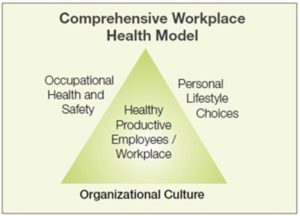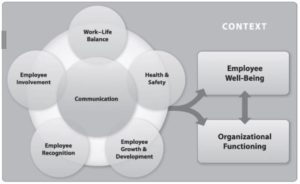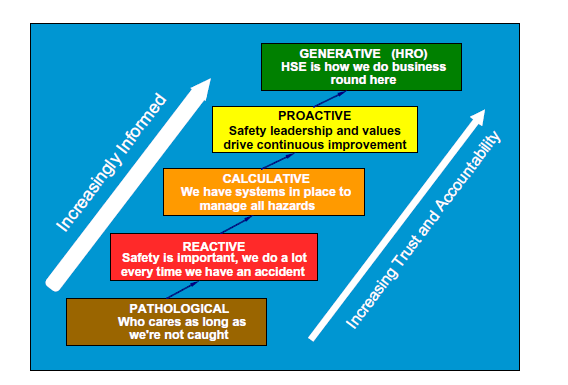Culture And Behaviours
Are we going through the Age of Integration?
The calls for change are legion. A decade ago, Dame Carol Black (1), called for health and wellbeing to be moved up the corporate agenda. IOSH (2) called on the UK Government to take health more seriously. Latterly, Stevenson and Farmer (3) lamented the organisational over-focus on physical safety risk. Notwithstanding these clarion calls, Vic Derbyshire, Quality Professional, Nuvia and David Day, Head of SHE, Nuvia think industries and organisations are transitioning through an era of change. But where have we come from?
Let’s reminisce…
The geeks amongst us may be aware of Hale and Hovden’s (1998) (4) Three Ages of Safety, which they describe as:
 The Technological Age – Here, humans were viewed as part of the machine of production; working in unison with the cogs and pistons, churning out products to power the Industrial Revolution. The belief was that most accidents were caused from technological failure; fix the machine and all will be well. The focus of safety management was to ensure the technology was safe to use.
The Technological Age – Here, humans were viewed as part of the machine of production; working in unison with the cogs and pistons, churning out products to power the Industrial Revolution. The belief was that most accidents were caused from technological failure; fix the machine and all will be well. The focus of safety management was to ensure the technology was safe to use.- The Human Factors Age – As things moved on, this age of safety management expanded its focus into how humans interact with technology. This is where we see the start of a systems thinking approach to safety and accident causation; for example, Reason’s Swiss Cheese Model. In this age, it was thought that management systems were designed to be tolerant of human fallibility; fix the system and everything will be fine. This created an obsession with rules and compliance; where humans were viewed as something to be controlled, something to be constrained. Control the human, control the risk.
- The Cultural Age – This age seems to build on the work of Reason and Dekker. This age sees humans, organisation and technology working as one. Here, failure is seen more as a consequence than a cause at the end of a sequence of events. Underlying or latent conditions lie dormant in the system waiting to be lined up with conditions on the front line. The focus here is on finding weaknesses before they develop further into serious incidents.
More recently, ARPANSA (2018) (5) have built on this structure arguing that safety is going through a fourth age:
- The Holistic Age – Here, the drive of safety management is to understand the complexity of the relation between technology, the human and the organisation. In this modern world, incidents are more than the human, more than the technology and more than the culture. The key to improvement is managing the relationship between these three interactions.
These ideas offer great insight, and we can all identify with the contexts, but we think something else is going on.
Yes, we are transitioning through a fourth age, through what Glendon et al. (2006) (6) have called the Age of Integration. However, we think this not simply a new age for safety. This is a new age for health and wellbeing also. An age where these three interrelated constructs are treated as equal. An age where each aspect is being integrated into the way we manage risk and the way we do business.
Drawing upon our research and personal experience, let us show you where we think this is happening.
Integration into policy
We can see a shift toward integration is happening at a policy level. For example, the International Labour Organization (ILO) has moved toward the idea of a “preventative culture”. The ILO (2013)(7) explain this concept to be a culture where governments, organisations and employees work together to give prevention of injury and ill health the highest priority.
Evidence shows that this concept has been adopted at international and domestic level. For example, at an international level the European Agency for Safety and Health (EUOSHA) has implemented this shift through its corporate aim, which is to work create and maintain a culture of prevention in Europe’s workplaces. This has then been disseminated to a national level. For example, in the context of the Norwegian petroleum industry, Hoivik et al. (2009)(8) report the drive of the Norwegian oil and gas regulator, through the implementation of a governmental white paper, encourage the extension of safety culture to include health, wellbeing and the environment. Once again, health and safety are given equal importance and the key is achieving prevention through an integrated approach to management of health, wellbeing and safety risks.
Integration into cultural models
We see integration of health, safety and wellbeing into culture models. Two great examples include the Comprehensive Workplace Health Model (figure 1) and the SHAPE Framework (figure 2).

Figure 1 – The Comprehensive Workplace Health Model (9)

Figure 2 – The SHAPE Framework (10)
Here, both models see the importance of health, safety and wellbeing in providing a positive working environment. In the Comprehensive Workplace Health Model, the emphasis for integration is the need to control risks. Workplace health is achieved by paying equal attention to personal lifestyle health, organisational culture and occupational health and safety. In the PATH Model, a review of research found that health, safety and wellbeing is a key workplace practice in improving employee wellbeing and organisational improvements. In both models, the management of health, safety and wellbeing are a key ingredient in continuous improvement.
Integration into health culture theory
From a research perspective, we see safety culture theory being in the context of health culture based on the work of Patrick Hudson (see figure 3).
In a multi-organisational study, Tappin et al. (2015) (11) have transferred the work of Hudson into the context of a specific health risk – musculoskeletal disorders. The Musculoskeletal Disorder Culture Assessment Tool allows organisations to assess their level of cultural maturity in the context of musculoskeletal risk management.
Each level has distinct characteristics and is a progression from the previous level. The range runs from the pathological, through the reactive, to the calculative, on to the proactive and then the final stage of generative.
Positively, it shows how Hudson’s safety culture work can be transferred into a health-specific context. The authors report the tool to be valuable in allowing the host organisations to gain an insight to their MSD cultural maturity.
Figure 3 – The Hudson Ladder (12)
Integration into our own organisation (Nuvia UK)
We started by integrating health and wellbeing into your business planning processes. We reviewed our health and safety policy and we extended one of our strategic aims to include the elimination or reduction of health and wellbeing risks. To achieve this, we started to set corporate simple health and wellbeing key performance indicators several years ago. We did things like increasing the number of daily messages on health and wellbeing; we extended our processes to recognise health and wellbeing risks; and sent out health and wellbeing newsletters.
Next, we integrated health and wellbeing into our existing risk assessment processes. We are in a quite fortunate position as risk assessment is an inherent part of the nuclear industry, consequently our risk assessment processes are embedded into everything we do. It was quite easy to make a big change with a little tweak; we took our standard risk assessment proforma and separated health from safety and included more health-related terminology in the guidance.
Finally, we integrated health and wellbeing into our existing communication processes. We used a legion of communication methods to promote health and wellbeing – on site tool box talks, daily on screen messages, monthly team briefings, themed Senior Management Walkrounds, monthly health and wellbeing newsletters, a health and wellbeing intranet site rich with information, onsite health awareness campaigns, lunch and learns, trade union-led wellbeing programmes. We got the message out there, everywhere!
In the end…
We see integration into policy, we see integration into cultural models, we see integration into health culture theory, and we see integration into the culture of organisations. Now is the time to harness this energy and integrate, integrate and integrate!
References
4 – Hale, A. R., & Hovden, J. (1998). ‘Management and culture: the third age of safety. A review of approaches to organizational aspects of safety, health and environment.’ Occupational Injury: Risk, Prevention and Intervention.
6 – Glendon, A. I., Clarke, S. G., & McKenna, E. F. (2006). ‘Human safety and risk management.’
8 – Høivik, D., Moen, B.E., Mearns, K. & Haukelid, K. (2009). ‘An explorative study of health, safety and environment culture in a Norwegian petroleum company’. Safety Science.
11 – Tappin, D.C., T.A. Bentley, T.A. & L.E. Ashby, L.E. (2015). ‘An implementation evaluation of a qualitative culture assessment tool’. Applied Ergonomics.
12 – Hudson, P.T.W. (2007). Implementing a safety culture in a major multi-national. Safety Science.
Are we going through the Age of Integration?
The calls for change are legion. A decade ago, Dame Carol Black, called for health and wellbeing to be moved up the corporate agenda. IOSH called on the UK Government to take health more seriously. Latterly, Stevenson and Farmer lamented the organisational over-focus on physical safety risk.
David Day
SHP - Health and Safety News, Legislation, PPE, CPD and Resources Related Topics
British Safety Council Wellbeing Conference: Empowering Employees for Success
Workers facing uncertain future coupled with health and safety risks, new IOSH report says
New flexible working legislation – what does it mean?

 The Technological Age – Here, humans were viewed as part of the machine of production; working in unison with the cogs and pistons, churning out products to power the Industrial Revolution. The belief was that most accidents were caused from technological failure; fix the machine and all will be well. The focus of safety management was to ensure the technology was safe to use.
The Technological Age – Here, humans were viewed as part of the machine of production; working in unison with the cogs and pistons, churning out products to power the Industrial Revolution. The belief was that most accidents were caused from technological failure; fix the machine and all will be well. The focus of safety management was to ensure the technology was safe to use.

